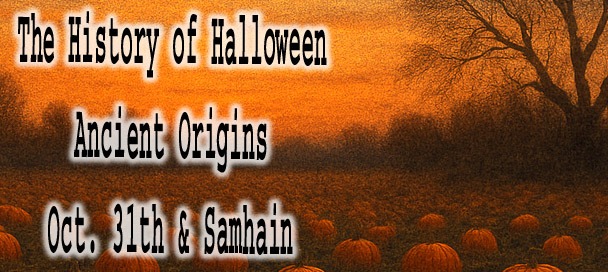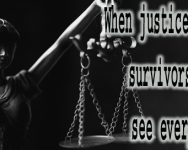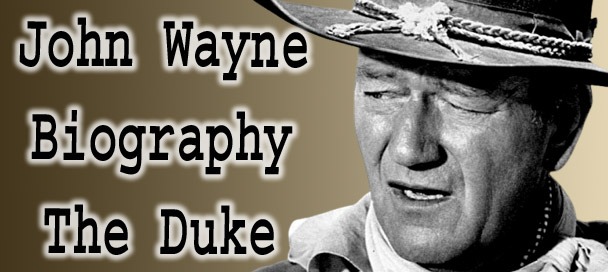🧟 Glenn Strange: The Other Frankenstein Who Stole the Show
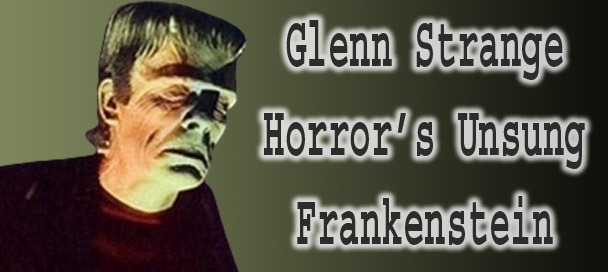
Glenn Strange as Frankenstein’s Monster in full makeup
Glenn Strange didn’t need dialogue to make an impression just bolts, boots, and a stare that could stop a heart. Best known for playing Frankenstein’s Monster in the final wave of Universal horror films, Strange brought a hulking, tragic presence to the role that stood shoulder-to-shoulder with Boris Karloff’s original.
Glenn Strange (1899-1973) was an actor whose tall frame, tragic stillness, and hulking presence redefined Frankenstein’s Monster for a generation. Born on a ranch in what was then New Mexico Territory, he worked as a rodeo performer, ranch hand, and deputy sheriff before Hollywood found him. He starred in westerns, but it was his casting by Universal on Lon Chaney Jr.’s recommendation and under the makeup of Jack Pierce that made him an icon. Later, as Sam the bartender on Gunsmoke, he traded monsters for saloon stools still massive in presence, still unforgettable. He’s remembered not for flashy lines, but for a look and weight that carry decades.
Born tall, broad, and with the kind of face Hollywood rarely forgot, Strange started out in westerns playing outlaws, deputies, and bartenders. But it was Jack Pierce’s makeup brush and Lon Chaney Jr.’s recommendation that transformed him into a Universal monster legend.
While some fans once saw him as “the other guy in the suit,” Strange’s portrayal in House of Frankenstein (1944), House of Dracula (1945), and Abbott and Costello Meet Frankenstein (1948) gave the creature surprising sympathy, strength, and screen presence.
And the irony? He wasn’t a horror guy. Off-screen, he played the fiddle, joked with castmates, and was beloved by western fans eventually becoming a household face in a very different genre.
He didn’t need words or light to be unforgettable. Glenn Strange lived in shadow and silence, delivering far more than what the monster suit could show.
👶 Early Life
Glenn Strange was born on August 16, 1899, in Weed, New Mexico Territory before it even became a state. Raised on a ranch, he grew up riding horses, branding cattle, and playing the fiddle at local dances. He was a real cowboy long before he ever played one on screen.
His family was of Irish and Cherokee descent, and Strange spoke Cherokee fluently as a child. He was a tall, imposing figure even in his teens, standing well over six feet by adulthood, which later helped him land roles that required physical presence.
Before acting ever entered the picture, he worked as a deputy sheriff, rodeo performer, and ranch hand. He didn’t come from a theatrical background in fact, Hollywood was about as far removed from his upbringing as it could get.
But after years of rodeo touring, he caught the eye of early western filmmakers in the 1930s who needed authentic cowboys who could handle both a horse and a fistfight. That’s how Glenn Strange made his quiet, steady entrance into show business.
Explore the Biographies of Iconic Celebrities
🎬 Film and TV Career
Glenn Strange’s film career began in the early 1930s, where he quickly established himself as a reliable heavy in westerns. With his towering 6’5” frame and naturally grim features, he became a go-to villain for studios churning out dozens of shoot-’em-ups. He appeared in films alongside stars like Roy Rogers, Gene Autry, and Hopalong Cassidy, often cast as the outlaw, henchman, or intimidating saloon regular.
He worked regularly with directors like Lesley Selander and Sam Newfield, showing up in titles such as The Lone Rider Rides On (1941), The Mad Monster (1942), and Border Badmen (1945). His horror breakthrough came in 1944 when Universal Pictures tapped him to take over the role of Frankenstein’s Monster from Bela Lugosi and Boris Karloff.
Strange played the Monster in three official Universal films: House of Frankenstein (1944), House of Dracula (1945), and the fan-favorite Abbott and Costello Meet Frankenstein (1948). While Karloff originated the role, it was Glenn Strange’s hulking figure that many younger fans first associated with the creature especially as his image became widely used in magazines, toys, and Halloween masks. Karloff even trained Strange for the role, coaching him on posture and movement while Strange underwent hours of makeup under Jack Pierce’s legendary brush.
Strange didn’t stop at monsters. He remained one of the most active character actors in Hollywood throughout the ’50s and ’60s, showing up in dozens of westerns like The Lone Ranger, The Cisco Kid, Wagon Train, and Rawhide. But it was Gunsmoke that brought him lasting fame on the small screen.
From 1961 until his death in 1973, Strange played Sam Noonan, the bartender at the Long Branch Saloon, on Gunsmoke appearing in over 200 episodes. He worked alongside series regulars like James Arness (Marshal Matt Dillon), Amanda Blake (Miss Kitty), Milburn Stone (Doc), and Ken Curtis (Festus). Despite his limited lines, Strange became a beloved fixture on the show, grounding the saloon scenes with quiet strength and warm presence.
He also appeared in episodes of Bonanza, The Rifleman, Have Gun Will Travel, The Adventures of Rin Tin Tin, and Death Valley Days, always playing some variation of the rugged western man: tough but not without depth.
Glenn Strange’s long TV and film career blended horror and the western, two of America’s most enduring screen genres. Whether lurching through a foggy castle or pouring drinks in Dodge City, he became the kind of familiar face audiences loved to spot silent, steady, and unforgettable.
🧟♂️ Frankenstein Meets the Wolf Man & House of Frankenstein – Universal’s Monster Mash Classics
Two monster-packed features starring horror legends Bela Lugosi, Lon Chaney Jr., Glenn Strange, Boris Karloff, and John Carradine come together in this thrilling double feature that defined the golden age of Universal horror.
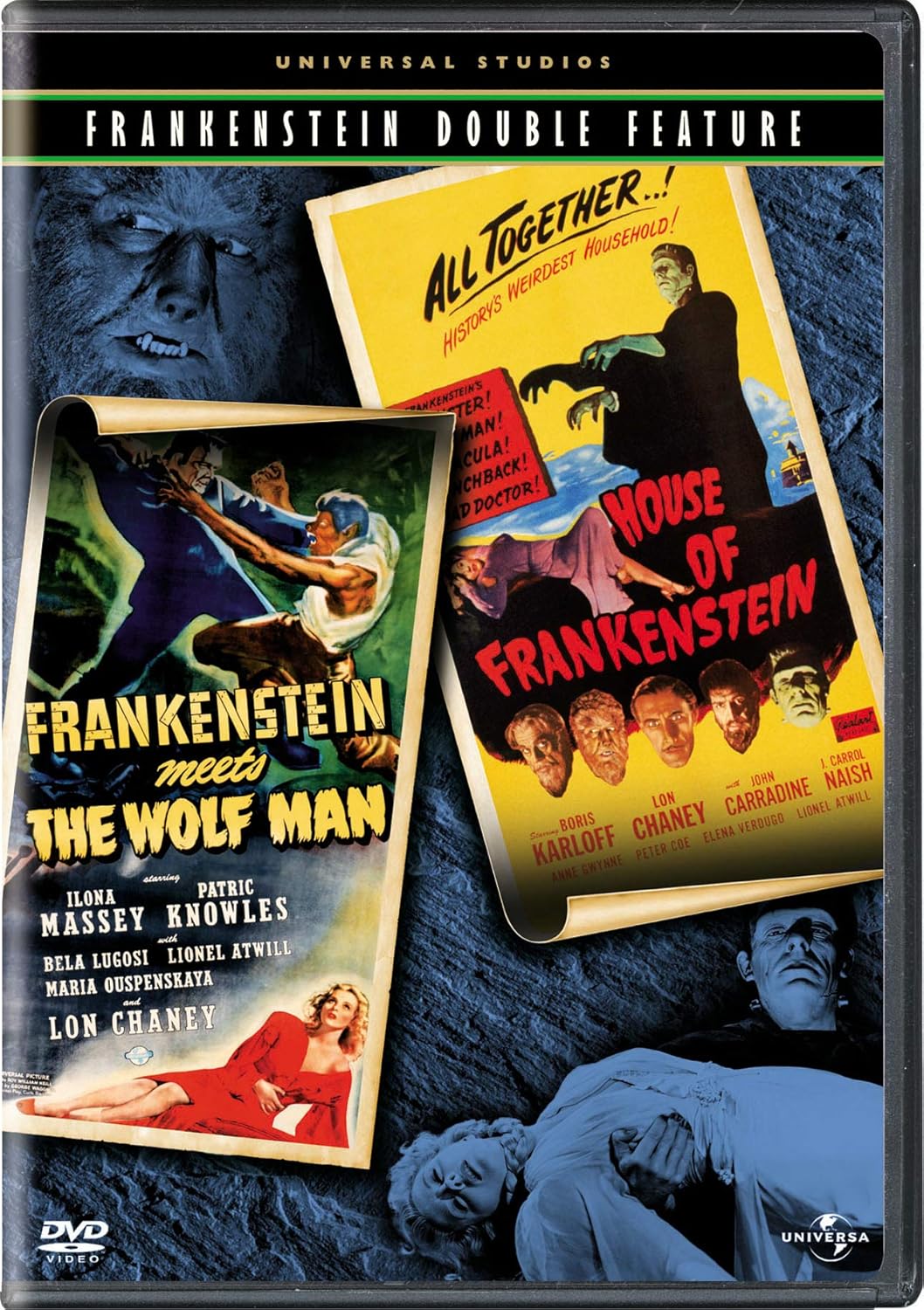
A monstrous pairing of Frankenstein's most unforgettable films.
In Frankenstein Meets the Wolf Man (1943), Lon Chaney Jr. reprises his iconic role as Larry Talbot, the cursed Wolfman, resurrected and desperate for a cure. When his search brings him to the ruins of Frankenstein’s castle, he finds the frozen body of the Monster now played by Bela Lugosi.
What follows is part gothic horror, part supernatural action movie, as these two titans are manipulated by a power-hungry scientist (Patrick Knowles) and brought back to life with devastating consequences. Directed by Roy William Neill, the film bridges Universal’s werewolf and Frankenstein mythologies into one moody, fog-drenched saga that still thrills.
Then in House of Frankenstein (1944), the madness kicks into overdrive. Boris Karloff returns not as the Monster, but as deranged scientist Dr. Niemann, who escapes from prison and commandeers a traveling horror exhibit. Along the way, he revives Count Dracula (John Carradine), uncovers the Wolf Man (Chaney) frozen in ice, and resurrects the Frankenstein Monster this time played by Glenn Strange in his debut as the creature. With each resurrection, the body count climbs and loyalties unravel. Karloff plays Niemann with tragic obsession, while John Carradine offers a fresh take on Dracula commanding, menacing, and more theatrical than ever.
Glenn Strange’s Monster towers with physicality, and Lon Chaney Jr. delivers his most anguished performance as Talbot, torn between death and redemption. The ensemble cast reads like a roll call of horror greats, making this not just a film but a cinematic monster summit.
This DVD features two of Universal’s most iconic crossovers, lovingly restored, and packed with all the lightning bolts, mad science, and monster brawls a fan could want.
🛒 Buy Frankenstein Meets the Wolf Man / House of Frankenstein on DVD 🧟♂️
🕊️ Later Years
By the 1960s, Glenn Strange had fully transitioned from Universal horror to western television especially Gunsmoke, where he became a beloved regular. As Sam the bartender, he wasn’t the center of attention, but he brought warmth and familiarity to the Long Branch Saloon. Cast and crew loved him. He was known for his easygoing attitude, quick wit, and loyalty to the show.
Strange continued to make occasional horror appearances at fan events and was always gracious with autographs. Despite playing Frankenstein’s Monster a role that came with heavy makeup, prosthetics, and hours in the chair he never distanced himself from it. In fact, he was proud of it. He knew that while he wasn’t the first Frankenstein, he was the one plastered on trading cards, comic books, and monster masks sold to kids in the 1950s and ‘60s.
He appeared in his final Gunsmoke episode in 1973. That same year, health issues worsened, and Strange was diagnosed with lung cancer. He passed away on September 20, 1973, at the age of 74.
But in classic Glenn Strange fashion, he kept working almost until the very end reliable, respected, and deeply appreciated both on and off screen. His legacy wasn’t built on spotlight-stealing roles but on consistency, character, and that rare ability to make a small part memorable.
🏆 Legacy
Glenn Strange may not have had the marquee name of a Karloff or Lugosi, but his legacy looms just as large literally and figuratively. For generations of horror fans, his version of Frankenstein’s Monster became the most recognizable. His square-jawed, towering frame graced countless posters, trading cards, lunchboxes, and Halloween costumes long after the original films left theaters.
He became the “monster in the mask,” the Frankenstein face that kids saw in Famous Monsters of Filmland and on Saturday afternoon TV. His portrayal brought a physical strength and tragic stillness to the creature, one that stuck in the cultural imagination.
Yet his legacy doesn’t end in a castle laboratory. As Sam the bartender on Gunsmoke, he became part of one of the longest-running and most beloved shows in television history. Week after week, he shared scenes with legends like James Arness and Amanda Blake, adding quiet charm and dependability to Dodge City’s saloon.
He was the kind of actor who never tried to steal the scene but somehow, you always remembered him. Whether he was lurching through a foggy crypt or pouring whiskey behind the bar, Glenn Strange made his mark through subtlety, presence, and a professionalism that earned him the respect of fans, filmmakers, and fellow actors alike.
🗣️ Why They Still Matter
Glenn Strange matters because he bridged horror and westerns, fear and familiarity. As Frankenstein’s monster, he became the face many fans first thought of—even though he wasn’t the original. On Gunsmoke, he proved that magnified presence and quiet dependability matter just as much as screams. His legacy endures in every monster mask, every western saloon, and in every actor who knows the power of being seen—even when almost hidden.
Further Reading & Resources
📖 Read: The Other Frankenstein Monster – The Strange Fate of Glenn Strange
🔍 Explore: Glenn Strange – Western Villain and Frankenstein Monster

ML Lamp is the owner of Kilroy Was Here. After his 20 years of working in Las Vegas in the entertainment promotions field, Mr. Lamp retired in 2002 from his job to pursue his passion for collectibles. Now as a guest speaker and author he’s living the dream, and sharing his warmth with You.

